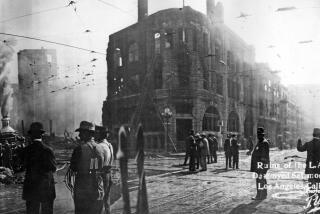New Mexico Researchers Trying to Thwart Terrorist Bombs
- Share via
SOCORRO, N.M. — Susan Walton still nurses the broken legs she suffered the day she walked into a credit union to deposit a check, only to have the floor blown out from under her.
“I fell about three stories. My injuries? Well, from head to toe. Nerve damage behind both eyes; I broke my nose and my jaw in six places; I had a ruptured spleen; I severely broke both legs from the knees down,” she says.
The credit union was in the Alfred P. Murrah Federal Building in Oklahoma City.
The day was April 19, 1995.
A truck containing 4,800 pounds of fertilizer and diesel fuel blew up in front of the building, killing 168 people.
“Me and one other lady were the only ones who survived in that particular area of the building,” Walton, who since has undergone nearly 20 surgeries, said in a telephone interview.
The blast--along with other tragedies such as the 1988 crash of a Pan Am Boeing 747 over Lockerbie, Scotland, that killed 270, including 11 on the ground, and the 1993 bombing of the World Trade Center in New York that left six people dead--provided the impetus for the new Counter Terrorist Explosives Research Center at the New Mexico Institute of Mining and Technology.
“Whatever they come up with maybe could help--maybe even with natural disasters,” Walton says.
The research center’s goal is to provide a national test facility for blast-resistant technology, says Van Romero, director of New Mexico Tech’s Energetic Materials Research and Testing Center, which oversees the school’s anti-terrorism work.
“We will develop techniques on how to protect structures and individuals from bomb attacks, both internal and external to buildings,” he says.
“We want to understand the basic chemistry and physics of how a terrorist bomb works and how it interacts with structures in order to predict how a structure will respond to blasts,” Romero says.
The center received $3 million in start-up funding this year from the U.S. Defense Department, beginning what Romero expects to be a five- to seven-year program.
“Terrorism is, unfortunately, a growth industry,” he says.
It has triggered a flurry of anti-terrorism activity, including legislation passed this year to increase federal authority to fight terrorism.
On the eve of the first anniversary of the Oklahoma bombing, Congress sent President Clinton a bill giving federal law officers new powers to use against terrorism and requiring tiny chemical markers in plastic explosives. He later signed the measure, as well as a $1.1-billion anti-terrorism package that includes money to improve security at U.S. facilities, bolster air safety and beef up law enforcement. As part of the package, the president and Congress agreed to study whether attaching taggants to black and smokeless powders, commonly used in making bombs, would help in tracing their origin.
A who’s who of federal agencies in the battle against terrorism is involved in the research center: the FBI; the CIA; the Bureau of Alcohol, Tobacco and Firearms; the Federal Aviation Administration; the State Department; the Department of Energy; the Justice Department; the Department of Transportation and the Treasury Department.
“We know what kind of bombs terrorists are using,” Romero said. “Now we also have to anticipate what they’ll be using in the future--and testing them.”
The research center will have two test beds on part of the energetic materials center’s 32-square-mile test range on a desert mountain west of Socorro.
“One will be testing small-scale items, like window panels, structural support columns, individual components of buildings and also how individual terrorist bombs work,” Romero said.
The second test site will have a structure--perhaps a five-story office building--where small bombs will be touched off inside and outside.
“We will use it for training, such as forensic evidence gathering,” Romero said.
Computer models will be fashioned from the tests and used to predict how the building would react to a full-blown terrorist attack.
The building eventually will be blown up--perhaps in three or four years--and those results will be used to validate the computer models, Romero said.
The research center will test bombs ranging from the fertilizer and diesel fuel combination to their No. 1 choice for airplanes--small plastic explosives.
“We can’t test every possible terrorist bomb. It’s an infinite number. What we have to do is a broad study of what are the key devices that span this spectrum,” Romero said.
The mixture of fertilizer and diesel fuel--items easy to obtain and assemble--is used in the mining industry to heave dirt off bodies of ore, he said.
“If you want to impart the most destruction on a building, that’s the type of explosive you would use. It heaves large quantities of mass a few feet,” Romero said.
Bombs made from the mixture “don’t have a tendency to detonate when you don’t want them to,” Romero noted. “And they’re hard to trace.”
One of the first things researchers will look at are windows, because most people killed inside buildings die from flying glass.
A task force commissioned by the Pentagon found that glass fragmentation caused 12 of the 19 deaths of U.S. airmen in a June 25 bombing that demolished the side of an apartment complex at Dhahran, Saudi Arabia.
Researchers will try to figure out how much explosive it takes to propel window shards to lethal velocities, Romero said--then try to determine how to strengthen windows.
They also will be interested in strengthening buildings, relying on previous studies on protecting structures from earthquakes, he said.
“One of the things we’ll be looking at in buildings is: Can we keep them from collapsing?”
“Our goal is to not add any cost to the price of a building,” he said. “We want to build them smarter and make them more resistant to blasts.”
More to Read
Sign up for Essential California
The most important California stories and recommendations in your inbox every morning.
You may occasionally receive promotional content from the Los Angeles Times.










